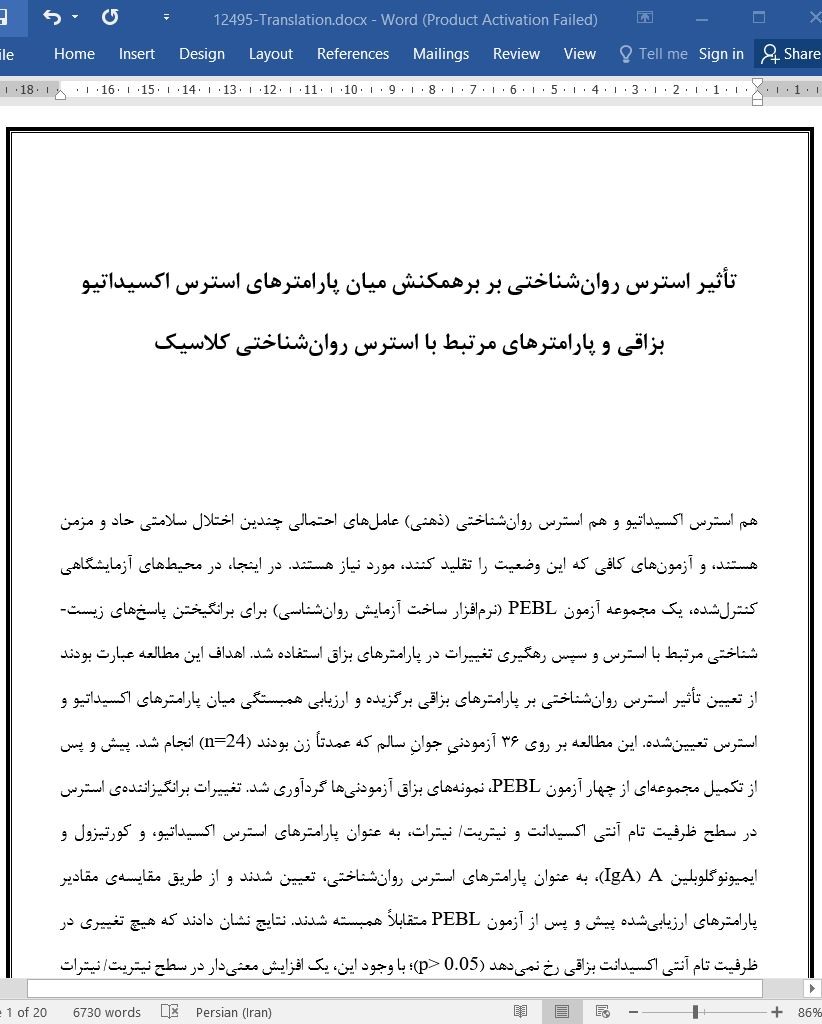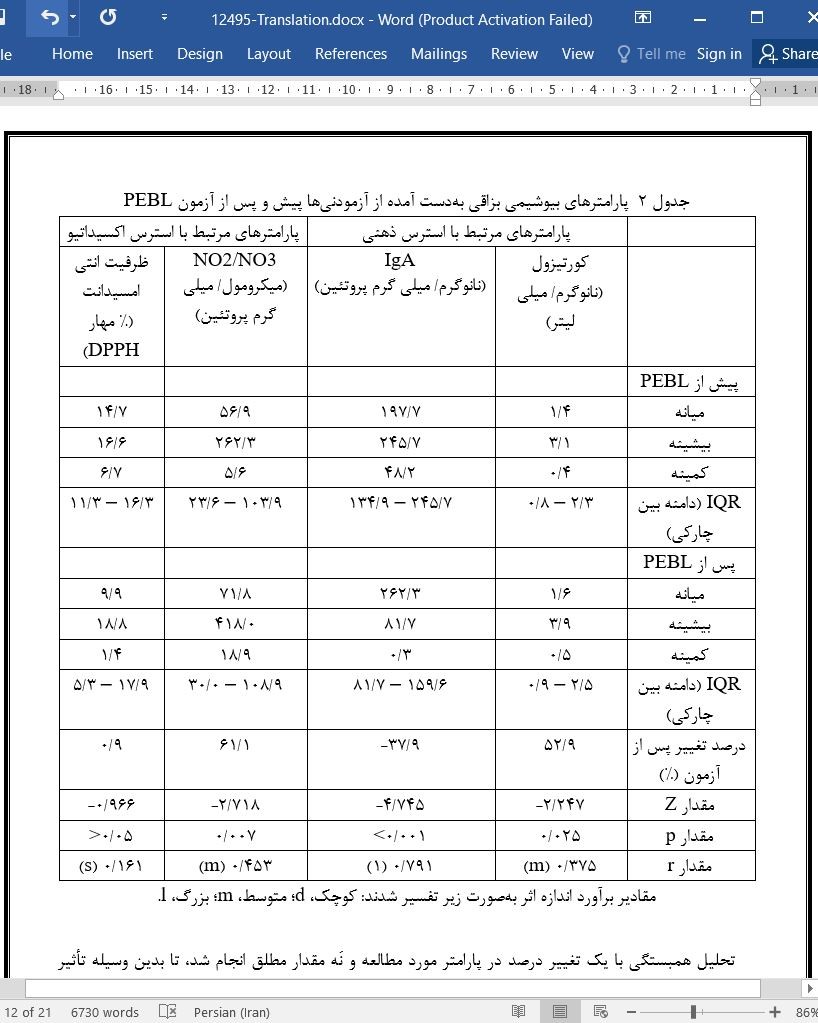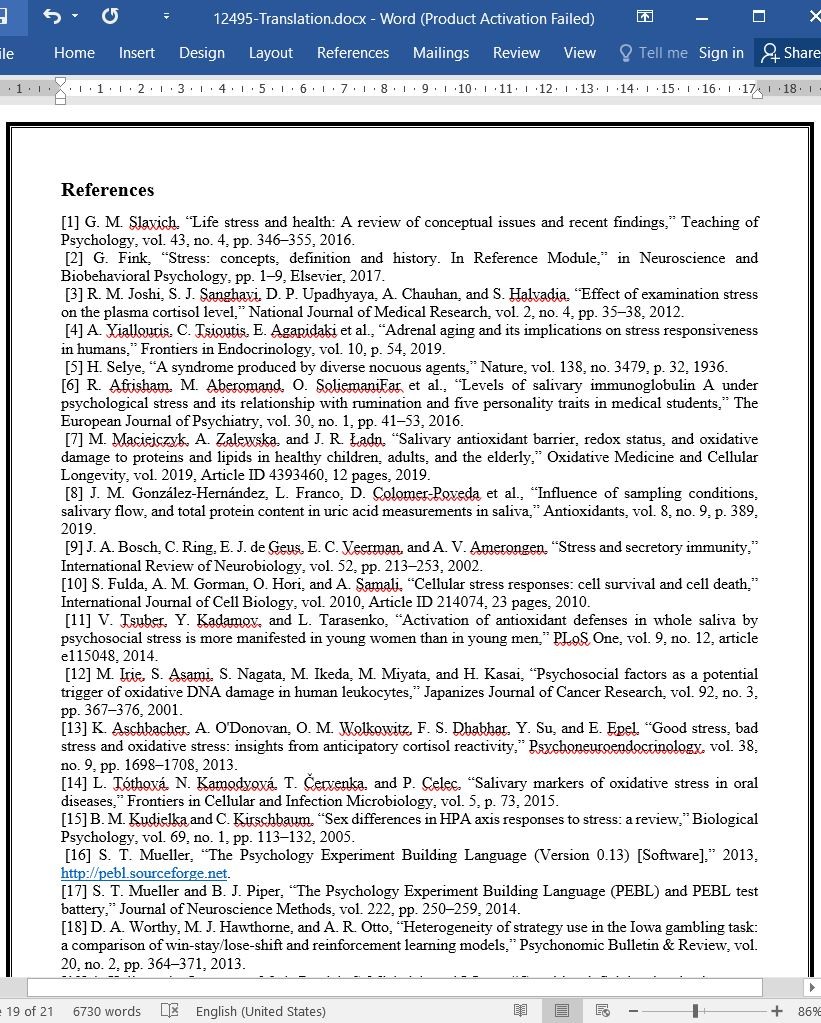
تاثیر استرس روان شناختی بر برهمکنش میان پارامترهای استرس اکسیداتیو بزاقی
هم استرس اکسیداتیو و هم استرس روان شناختی (ذهنی) عامل های احتمالی چندین اختلال سلامتی حاد و مزمن هستند، و آزمون های کافی که این وضعیت را تقلید کنند، مورد نیاز هستند. در اینجا، در محیط های آزمایشگاهی کنترل شده، یک مجموعه آزمون PEBL (نرم افزار ساخت آزمایش روان شناسی) برای برانگیختن پاسخ های زیست-شناختی مرتبط با استرس و سپس رهگیری تغییرات در پارامترهای بزاق استفاده شد. اهداف این مطالعه عبارت بودند از تعیین تأثیر استرس روان شناختی بر پارامترهای بزاقی برگزیده و ارزیابی همبستگی میان پارامترهای اکسیداتیو و استرس تعیین شده. این مطالعه بر روی 36 آزمودنیِ جوانِ سالم که عمدتاً زن بودند (n=24) انجام شد. پیش و پس از تکمیل مجموعه ای از چهار آزمون PEBL، نمونه های بزاق آزمودنی ها گردآوری شد. تغییرات برانگیزاننده ی استرس در سطح ظرفیت تام آنتی اکسیدانت و نیتریت/ نیترات، به عنوان پارامترهای استرس اکسیداتیو، و کورتیزول و ایمیونوگلوبلین A (IgA)، به عنوان پارامترهای استرس روان شناختی، تعیین شدند و از طریق مقایسه ی مقادیر پارامترهای ارزیابی شده پیش و پس از آزمون PEBL متقابلاً همبسته شدند. نتایج نشان دادند که هیچ تغییری در ظرفیت تام آنتی اکسیدانت بزاقی رخ نمی دهد (p> 0.05)؛ با وجود این، یک افزایش معنی دار در سطح نیتریت/ نیترات پس از آزمون PEBL روی داد (p= 0.007). از سوی دیگر، سطح کورتیزول تعیین شده پس از مجموعه آزمون، در مقایسه با مقادیر به دست آمده پیش از آزمون، از نظر آماری افزایش یافت (p= 0.025) در حالی که سطح IgA از نظر آماری به طور معنی داری کاهش یافت (p< 0.001). تنها همبستگی معنی دار از نظر آماری میان تغییرات در پارامترهای مطالعه شده، تغییرات میان سطح کورتیزول و IgA بود (Ro= -0.4 اسپرمن). این نتایج دلالت بر آن دارند که استرس کوتاه مدتی که به وسیله ی آزمون PEBL القا شده بود باعث برانگیختن تغییراتی در پارامترهای مرتبط با استرس ذهنی بزاقی می شود (افزایش در سطح کورتیزول و نیتریت/ نیترات، و کاهش در IgA)، اما در ظرفیت تام آنتی اکسیدانت چیزی رخ نداد. آن ها همچنین دلالت بر آن دارند که مجموعه ی چهار آزمونی PEBL ساخته شده ممکن است نمایانگر یک الگوی القاکننده ی استرس آزمایشگاهیِ کافی باشد.
6- نتیجه گیری
نتایج به دست آمده دلالت بر آن دارد که مجموعه آزمون PEBL متشکل از چهار آزمون، ممکن است یک الگوی القاکننده ی استرس آزمایشگاهی کافی نمایان کند چون یک پاسخ زیست شناختی را برمی انگیزد که باعث افزایش چشمگیر در سطح کورتیزول بزاقی و NO2/No3 می شود، در حالی که منجر به یک کاهش در سطح IgA می-شود. از سوی دیگر، اگرچه تغییراتی در پارامترهای زیست شناختی مرتبط با استرس القا شد، اما بر ظرفیت آنتی اکسیدانت بزاقی تأثیر نگذاشت. این نتایج دلالت بر آن دارد که استرس کوتاه مدت حاد که به وسیله ی مجموعه آزمون PEBL مورد استفاده در اینجا القا می شود، تغییراتی در پارامترهای مرتبط با استرس ذهنی بزاقی برمی انگیزد، اما در ظرفیت تام آنتی اکسیداتیو تغییری پدید نمی آورد.
Both oxidative and psychological (mental) stress are the likely culprits for several acute and chronic health disturbances, and adequate tests mimicking that are needed. Herein, in controlled laboratory surroundings, a PEBL (Psychology Experiment Building Language) test battery was used to evoke stress-related biological responses followed by tracking changes in saliva parameters. The study objectives were to determine the impact of psychological stress on selected salivatory parameters and to assess the correlation between the determined oxidative and stress parameters. The study was conducted on 36 healthy young subjects, mainly females (n = 24). Before and following the completion of a battery of four PEBL tests, subjects’ saliva samples were collected. Stress-evoking changes in total antioxidant capacity and nitrite/nitrate levels, as oxidative stress parameters, and cortisol and immunoglobulin A (IgA), as parameters of psychological stress, were established and mutually correlated by comparing the values of the evaluated parameters pre- and post-PEBL test. The results showed that there is no change in the total salivary antioxidant capacity (p > 0:05); however, there was a significant increase in nitrites/nitrates levels after the PEBL test (p = 0:007). On the other hand, the determined cortisol levels after the test battery were found to be statistically significantly increased (p = 0:025) when compared to the values obtained before the test, while the levels of IgA were found to be statistically significantly decreased (p < 0:001). The only statistically significant correlation between the changes in the studied parameters was found to be the one between cortisol and IgA levels (Spearman’s Rö = -0.4). These results suggest that the short-term stress induced by the PEBL test does evoke changes in the salivary mental stress-related parameters (an increase in cortisol and nitrite/nitrate levels, and a decrease in IgA), but not in the total antioxidant capacity. They also indicate that the constructed PEBL four-test battery might represent an adequate laboratory stress-inducing paradigm.
6. Conclusions
The obtained results indicate that the constructed PEBL test battery, consisting of 4 tests, might represent an adequate laboratory stress-inducing paradigm since it evokes biological response characterized by a significant increase in salivary cortisol and NO2 - /NO3 - levels, while it leads to a decrease in IgA levels. On the other hand, although it induced the changes in stress-related biological parameters, it did not affect salivary antioxidative capacity. These results suggest that the acute short-term stress induced by the PEBL test battery here used does evoke the changes in the salivary mental stress-related parameters, but not in the total antioxidative capacity.
چکیده
1- مقدمه
2- مواد و روش ها
2-1 آزمودنی ها.
2-2 طراحی مطالعه و مجموعه آزمون PEBL
2-3 تعیین سطح استرس روان شناختی
2-4 گردآوری نمونه و تعیین پروتئین
2-5 تحلیل های بیوشیمی
2-5-1 تعیین ظرفیت تام آنتی اکسیدانت بزاقی
2-5-2 تعیین کورتیزول بزاقی
2-5-3 تعیین IgA بزاقی
2-5-4 تعیین NO2/NO3 بزاقی
2-6 تحلیل آماری
3- نتایج
4- بحث
5- نقاط قوت و محدودیت های مطالعه
6- نتیجه گیری
منابع
ABSTRACT
1. Introduction
2. Materials and Methods
2.1. Subjects
2.2. Study and PEBL Battery Design
2.3. Psychological Stress Level Determination
2.4. Sample Collection and Protein Determination
2.5. Biochemical Analyses
2.5.1. Total Salivary Antioxidative Capacity Determination
2.5.2. Salivary Cortisol Determination
2.5.3. Salivary IgA Determination
2.5.4. Salivary NO2 - /NO3 – Determination
2.6. Statistical Analysis
3. Results
4. Discussion
5. Strengths and Limitations of the Study
6. Conclusions
References
- اصل مقاله انگلیسی با فرمت ورد (word) با قابلیت ویرایش
- ترجمه فارسی مقاله با فرمت ورد (word) با قابلیت ویرایش، بدون آرم سایت ای ترجمه
- ترجمه فارسی مقاله با فرمت pdf، بدون آرم سایت ای ترجمه



